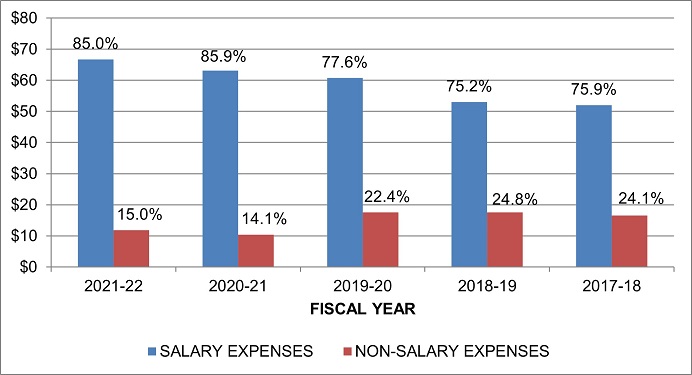Canadian Institutes of Health Research Annual Report 2021–22
Contents
- Chair’s Message
- Providing Stewardship and Accountability
- Financial Statement Discussion and Analysis
- Financial Statements
Message from the Chair of CIHR Governing Council

Alice Aiken
Interim Chair, CIHR Governing Council
On behalf of Governing Council, I am pleased to present the 2021-22 Annual Report of the Canadian Institutes of Health Research (CIHR), the Government of Canada’s health research investment agency.
This past year, as the COVID-19 pandemic persisted and the virus evolved into new variants of concern, CIHR continued to support the Canadian health research community as it conducted exceptional research and informed Canada’s response. As a result of these efforts, we were able to develop made-in-Canada, evidence-based solutions to the many challenges that Canadians faced during this pandemic, while also contributing to the global research effort.
Despite the challenges of the pandemic, the agency also remained focused on implementing the CIHR Strategic Plan 2021–2031: A Vision for a Healthier Future and its five priority areas:
- Advance research excellence in all its diversity;
- Strengthen Canadian health research capacity;
- Accelerate the self-determination of First Nations, Inuit, and Métis Peoples in health research;
- Pursue health equity through research; and,
- Integrate evidence in health decisions.
To ensure that the agency was well-positioned to deliver on these priorities, CIHR’s leadership team re-evaluated its organizational structure. A new Learning Health Systems portfolio was subsequently created, to help deliver on CIHR’s knowledge mobilization mandate as expressed in the CIHR Act. The goal of this new portfolio is to translate research into improved health for Canadians, more effective health services and products, and a strengthened health care system.
Advance research excellence in all its diversity
As part of the agency’s efforts to advance research excellence and promote open science, CIHR introduced a guide to help researchers adhere to international best practices related to the prompt reporting of clinical trials results.
This past year also saw the continuation of strong collaborations – both abroad and at home – to support research excellence. For example, CIHR continued its longstanding partnership with the European Commission with the announcement of joint transnational collaboration on neurodegenerative diseases, rare diseases, and antimicrobial resistance, among other topics. At home, CIHR worked with its tri-agency partners – the Natural Sciences and Engineering Research Council of Canada (NSERC) and the Social Sciences and Humanities Research Council (SSHRC) – as well as with the Canada Research Coordinating Committee (CRCC) to further coordinate efforts, such as:
- Releasing the 2021 Tri-Agency Framework for Responsible Conduct of Research to promote and protect the quality, accuracy, and reliability of research funded by the three federal research granting agencies;
- Launching Stage 1 of the Canadian Biomedical Research Fund and Biosciences Research Infrastructure Fund as part of Canada’s Biomanufacturing and Life Sciences Strategy;
- Releasing the first progress report on the implementation of the interagency strategic plan, Setting new directions to support Indigenous research and research training in Canada; and
- Announcing the SMART Healthy Cities Training Platform, which will develop an interdisciplinary, inter-sectoral training initiative that will generate cutting-edge knowledge and build capacity for implementation science and solutions-based research.
Strengthen Canadian health research capacity
Significant progress was also made on strengthening Canadian health research capacity, with a focus on promoting an equitable, diverse, and inclusive health research ecosystem that values the perspectives and contributions of all. As part of these efforts, the agency hosted virtual engagement sessions to facilitate open and productive conversations on the actions that CIHR can take to address systemic racism in the health research funding system. As well, the agency created the CIHR Anti-Racism External Advisory Committee and the CIHR External Advisory Committee on Accessibility and Systemic Ableism, to inform the development of CIHR’s anti-racism action plan and accessibility action plan, respectively.
CIHR continued to support the next generation of health researchers with an investment of $31.1 million over six years through the Health Research Training Platform (HRTP). Comprised of 13 unique training programs, the HRTP brings together researchers from hospitals and universities to increase Canada’s capacity to conduct research on specific disease areas and health challenges. This program, as well as CIHR’s other capacity development programs (including the Health System Impact Fellowship), will prepare the next generation of researchers to respond to a broad range of current and future needs.
CIHR’s priority to strengthen Canadian health research capacity also includes a commitment to enhancing CIHR’s rapid response capacity. As part of the continued response to the pandemic, CIHR launched various funding opportunities focused on COVID-19 to study the virus as well as the broader impacts of the pandemic, including impacts on equity-seeking communities, and children, youth, and families.
The COVID-19 pandemic has taught us many lessons, including the importance of enhancing our resiliency to future pandemics and health emergencies. In response, CIHR announced the creation of the Centre for Research on Pandemic Preparedness and Health Emergencies, with an ongoing investment of $18.5 million per year. The Research Centre is dedicated to growing Canada’s capacity to create and mobilize knowledge to prevent, prepare for, respond to, and recover from existing and future pandemics and public health emergencies.
Accelerate the Self-Determination of Indigenous Peoples in Health Research
CIHR continues to advance its Action Plan: Building a healthier future for First Nations, Inuit, and Métis Peoples, which commits to a series of concrete actions to further strengthen Indigenous health research in Canada. As part of these efforts, CIHR continues to work closely with Indigenous communities to build capacity for research and knowledge mobilization. Over the past year, this included the launch of Indigenous strategic funding opportunities, including research related to Indigenous COVID-19 rapid research, the wider health impacts of COVID-19, and the third phase of the Indigenous Gender and Wellness Initiative. CIHR is also advancing distinctions-based engagements and initiatives through directed grants co-developed with Indigenous organizations that are tailored to address Indigenous health issues, including the First Nations Biobanking and Genomic Research Initiative and the Inuit Research Network.
Pursue health equity through research
The COVID-19 pandemic has laid bare the interconnection between the health of Canadians and the health of people around the world, as the health threats that we face today are increasingly transnational in nature. In May 2021, CIHR released Global Health 3.0: CIHR’s Framework for Action on Global Health Research, which articulates CIHR’s new vision for global health research in Canada. Since the release of the Framework, CIHR has launched funding opportunities to support its implementation, including the Women Rise Initiative. A partnership with SSHRC and the International Development Research Centre, the initiative will support women’s health and economic empowerment for a COVID-19 recovery that is inclusive, sustainable, and equitable.
Integrate evidence in health decisions
CIHR continued to collaborate with federal colleagues to advance the evidence-based policy agenda of the Government of Canada. A key collaboration included CIHR’s involvement in the development of Canada’s Biomanufacturing and Life Sciences Strategy, through the Budget 2021 investment of $250 million over three years in the Clinical Trials Fund.
CIHR also continued to support research and knowledge mobilization activities that advance key Government of Canada priorities. For example, this past year CIHR launched funding opportunities to inform the development of national standards for delivering mental health and substance use services, as well as to advance the priorities outlined in the Chief Public Health Officer of Canada’s annual report for 2021. CIHR also supported colleagues in accessing the best available evidence through its Best Brains Exchanges program, including a session on the future of public health in Canada, as well as a session on surveillance and research needs to inform public health action aimed at preventing and managing the impacts of post-COVID-19 condition.
Through Canada’s Strategy for Patient-Oriented Research (SPOR), CIHR also continued to support activities that integrate the voices of patients in research and health care. For example, the newly launched SPOR National Training Entity will focus on enhancing the ways that the science of patient-oriented research is taught and conducted in Canada.
I invite you to read the financial details of this report to learn more about the investments that are allowing CIHR to support new scientific knowledge and enable its translation into improved health and a strengthened Canadian health care system.
Sincerely,
Alice Aiken
Interim Chair, CIHR Governing Council
Providing Stewardship and Accountability
CIHR Governing Council
CIHR reports to Parliament through the Minister of Health. Its Governing Council comprises a group of up to 18 distinguished Canadians who together provide oversight and strategic direction for the organization and evaluate its overall performance.

Jeannie Shoveller
Chair
(until December 31, 2022)
Vice President,
Research & Innovation, IWK Health Centre
Professor,
Community Health & Epidemiology, Dalhousie University

Debbie Fischer
Executive-in-Residence,
Rotman School of Management
Executive Associate, KPMG

Louise Lemieux-Charles
(until May 23, 2021)
Professor Emeritus,
Institute of Health Policy, Management and Evaluation
Dalla Lana School of Public Health
University of Toronto

Alice B. Aiken
Interim Chair
(as of January 1, 2022)
Vice-Chair
(until December 31, 2021)
Vice President (Research & Innovation)
Dalhousie University

Dominic Giroux
President and CEO,
Health Sciences North and the Health Sciences North Research Institute

Stephen Lucas
(Ex-officio, non-voting member)
Deputy Minister
Health Canada

Paul Allison
(until May 23, 2021)
Faculty of Dentistry
McGill University

Diane Gosselin
(until May 23, 2021)
President and Chief Executive Officer,
CQDM

Amélie Quesnel-Vallée
Professor,
Departments of Sociology & Epidemiology
McGill University

Brenda Andrews
University Professor,
Donnelly Centre for Cellular and
Biomolecular Research
Department of Molecular Genetics
University of Toronto

Nada Jabado
Senior Scientist,
RI‑MUHC Glen site
Child Health and Human Development Program

Michael Salter
Interim Vice-Chair
(since January 1, 2022)
Senior Scientist,
Neurosciences & Mental Health and Chief of Research Emeritus
The Hospital for Sick Children

Deborah DeLancey
(as of July 1, 2021)
Former Deputy Minister with the Government of the Northwest Territories

Shanthi Johnson
(as of July 1, 2021)
Professor and Dean
School of Public Health, University of Alberta

Michael Strong
(Ex-officio, non-voting member)
President, CIHR

Mark S. Dockstator
Associate Professor,
Trent University
Chanie Wenjack School of Indigenous Studies

Brianne Kent
Assistant Professor,
Simon Fraser University

Marcello Tonelli
Senior Associate Dean (Health Research),
Cumming School of Medicine
Associate Vice President (Health Research),
University of Calgary

Don Ferguson
Former Deputy Minister of Health for New Brunswick

Josette-Renée Landry
CEO, Institut du Savoir and Vice-President,
Research and Education at Montfort Hospital
Financial Statement Discussion and Analysis
Introduction
The following Financial Statement Discussion and Analysis (FSD&A) should be read in conjunction with the Canadian Institutes of Health Research (CIHR) audited financial statements and accompanying notes for the year ended March 31, 2022.
The responsibility for the integrity and objectivity of the FSD&A rests with the management of CIHR. The purpose of the FSD&A is to highlight information and provide explanations to enhance the user’s understanding of CIHR’s financial position and results of operations, while demonstrating CIHR’s accountability for its resources. Additional information on CIHR’s performance is available in the CIHR Departmental Results Report, and information on its plans and priorities is available in the CIHR Department Plan.
Overview
The Canadian Institutes of Health Research was established in June 2000 under the Canadian Institutes of Health Research Act. It is listed in Schedule II to the Financial Administration Act as a departmental corporation. CIHR’s objective is to excel, according to international standards of scientific excellence, in the creation of new knowledge, and its translation into improved health, more effective health services and products, and a strengthened Canadian health care system.
CIHR’s budget is allocated through authorities approved by Parliament. CIHR has separate voted authorities for operating expenses and for grants/awards. Authorities provided to CIHR by Parliament do not parallel financial reporting according to Canadian public sector accounting standards, since authorities are primarily based on cash accounting principles. Consequently, items recognized in the Statement of Financial Position, the Statement of Operations and Departmental Net Financial Position, the Statement of Change in Departmental Net Debt, and the Statement of Cash Flows are not necessarily the same as those provided through authorities from Parliament. Note 3 of the Financial Statements provides users with a reconciliation between the two bases of reporting.
Highlights
CIHR’s financial results in 2021-22 are consistent with those of the preceding fiscal year, taking into account the increase in parliamentary authorities available last fiscal year to support COVID-19 health research.
1. Statement of Financial Position
| As at March 31 | 2022 | 2021 | % change |
|---|---|---|---|
| Total liabilities | $13.4 | $14.1 | (5.0)% |
| Total financial and non-financial assets | $13.8 | $15.3 | (9.8)% |
The decrease in total liabilities of $0.7 million is primarily due to a decrease ($0.3 million) in the amount accrued for outstanding invoices to external vendors at year-end, as well as a decrease ($0.3 million) in payables due to other government departments. CIHR resumed the payout of excess compensatory leave in 2021-22 thereby reducing the accrual required for compensatory leave ($0.2 million). There was a decrease ($0.3 million) in the vacation accrual as more vacation was used in 2021-22 compared to 2020-21. This was offset by an increase of $0.4 million for the accrued salaries and wages.
The balance in total financial and non-financial assets decreased by $1.5 million due to a decrease ($1.3 million) in the net tangible capital assets. The acquisition of capital assets has decreased largely due to CIHR moving to a new office building in June 2024 and having to decommission its current data center. Most systems will be moved to the cloud requiring no further capital investment except for a few systems which will be moved to SSC’s Facility as a Service (FaaS) where a large capital investment will be required in 2023-24. There was also a decrease ($0.2 million) in the amount due from the consolidated revenue fund.
2. Statement of Operations and Departmental Net Financial Position
| For the year ended March 31 | 2022 | 2021 | % change |
|---|---|---|---|
| Total expenses | $1,396.7 | $1,517.3 | (7.9)% |
| Net cost of operations before government funding and transfers | $1,390.6 | $1,511.0 | (8.0)% |
The decrease in both total expenses (7.9%) and in net cost of operations before government funding and transfers (8.0%) are mainly attributable to the decrease ($231.3 million) in Parliamentary authorities provided to CIHR by the Government of Canada from the prior fiscal year. The decrease is primarily due to a decrease in COVID-19 funding CIHR received and distributed during the year.
3. Variance Analysis
3.1 Variances between current year actual results and budget
CIHR’s 2021-22 year-end Parliamentary authorities of $1,392.9 million represents a decrease of $231.3 million (or 14.2%) compared to CIHR’s 2020-21 year-end authorities ($1,624.2 million).
This decrease is a key factor to note when comparing current year and prior year results for CIHR. The main reason for the current year decrease is due to a decrease in grant funding to support COVID-19 research.
| 2021-22 Main Estimates (in millions of dollars) | $1,253.9 |
|---|---|
| Funding for COVID-19 medical countermeasures | 111.1 |
| Funding for the Centre for Research on Pandemic Preparedness and Health Emergencies | 17.8 |
| Funding for Diabetes research | 4.0 |
| 2020-21 Operating budget carry-forward | 2.9 |
| Funding for Supporting mental health affected by COVID-19 | 2.2 |
| Compensation adjustments from the Treasury Board Secretariat | 0.5 |
| Net transfers from other government departments | 0.3 |
| Funding to support pediatric cancer | 0.2 |
| Total increase in Parliamentary authorities | 139.0 |
| 2021-22 Year-end Parliamentary authorities | $1,392.9 |
3.2 Variances between current year actual results and prior year actual results
| For the year ended March 31 | 2022 | 2021 | % change |
|---|---|---|---|
| Grants and awards | $1,318.2 | $1,443.8 | (8.7)% |
| Operating expenses | $78.5 | $73.5 | 6.8% |
Grants and awards expenses decreased by 8.7% (or $125.6 million) in 2021-22 due to decreased Parliamentary authorities provided to CIHR to support grant funding (as outlined in section 3.1). Total operating expenses also increased by 6.8% ($5.0 million) over the previous year. This increase is mainly due to an increase of $3.6 million in salaries and employment benefits as a result of a 1.5% economic increase, as well as an increase of 41 FTEs compared to 2020-21. This increase results from the implementation of positions secured through the Federal Budget 2021, as well as the reinvestment of travel savings resulting from travel restrictions into temporary operational capacity and support to COVID-19 related funding opportunities.
In addition, there was an increase of $1.2 million for professional services expenditures related to a number of non-recurring contracts that were specific to fiscal year 2021-22. Finally, CIHR’s cost of accommodation for its current office space increased by $0.2 million, while the remaining categories experienced immaterial fluctuations compared to the prior year.
4. Trend Analysis
4.1 Grants and Awards Expenses
(in millions of dollars)

Grants and Awards Expenses – Long Description
| 2021–22 | 2020–21 | 2019–20 | 2018–19 | 2017–18 | |
|---|---|---|---|---|---|
| Authorities provided | $1,392.9 | $1,624.2 | $1,205.7 | $1,158.9 | $1,098.4 |
| Grants and awards expenses | $1,318.2 | $1,443.8 | $1,136.5 | $1,088.9 | $1,038.8 |
| Operating expenses | $78.5 | $73.5 | $78.3 | $70.5 | $68.5 |
| Percentage grants and awards | 94.4% | 95.2% | 93.6% | 93.9% | 93.8% |
| Percentage operating expenses | 5.6% | 4.8% | 6.4% | 6.1% | 6.2% |
- The proportion of grants and awards expenses in relation to changes in the Parliamentary authorities fluctuate minimally from year to year.
- In 2021-22, grants and awards expenses made up 94.4% of total expenses, as compared to 95.2% in 2020-21.
4.2. Operating Expenses
(in millions of dollars)

Operating Expenses – Long Description
| 2021-22 | 2020-21 | 2019–20 | 2018–19 | 2017–18 | |
|---|---|---|---|---|---|
| Salary expenses | $66.7 | $63.1 | $60.7 | $53.0 | $52.0 |
| Non-salary expenses | $11.8 | $10.4 | $17.5 | $17.5 | $16.5 |
| Total | 78.5 | 73.5 | 78.2 | 70.5 | 68.5 |
| Percentage salary expenses | 85.0% | 85.9% | 77.6% | 75.2% | 75.9% |
| Percentage non-salary expenses | 15.0% | 14.1% | 22.4% | 24.8% | 24.1% |
- The ratio of operating expenses to total expenses was 5.6% in 2021-22, as compared to 4.8% in 2020-21.
- Salary and employee benefit expenses increased by $3.6 million (or 5.4%) in 2021-22, as discussed in 3.2.
- In 2021-22, salaries and employee benefits made up 85.0% of total operating expenses, as compared to 85.9% in the prior year.
Financial Outlook – 2022-23
CIHR continues to be driven by Government of Canada priorities, and maintains its support to the research community in 2022-23. CIHR’s commitment to raise investments for graduate students and improve equity, diversity and inclusion in the research system remain essential goals for the Agency.
Budget 2022 announced new funding for CIHR related to COVID-19, Black researchers, and dementia and brain health research.
In order to continue COVID-19 research and further understand its lasting impacts, Budget 2022 announced $20 million to CIHR over five years, starting in 2022-23, to support additional research on the long-term effects of COVID-19 infections on Canadians, as well as the wider impacts on health and health care systems.
CIHR is committed to improve equity, diversity and inclusion in the research system, therefore, together with SSHRC and NSERC, the Tri-Agency has prioritized increasing opportunities for Black researchers. To support this, Budget 2022 announced $15 million to CIHR over five years, starting in 2022-23, and $4 million ongoing, to support targeted scholarships and fellowships for promising Black student researchers.
It is estimated that one in four Canadian seniors over the age of 85 are diagnosed with dementia. The effects of this disease on both those living with dementia and those caring for them can be devastating. Budget 2022 announced $20 million to CIHR over five years, starting in 2022-23, to increase research in the area of dementia and brain health in order to improve treatment and outcomes for those living with dementia, as well as, to learn more about the mental health consequences for caregivers and evaluate different models of care.
Financial Statements
Canadian Institutes of Health Research
Statement of Management Responsibility Including Internal Control over Financial Reporting
Responsibility for the integrity and objectivity of the accompanying financial statements for the year ended March 31, 2022, and all information contained in these financial statements rests with the management of the Canadian Institutes of Health Research (CIHR). These financial statements have been prepared by management using the Government of Canada’s accounting policies, which are based on Canadian public sector accounting standards.
Management is responsible for the integrity and objectivity of the information in these financial statements. Some of the information in the financial statements is based on management's best estimates and judgment, and gives due consideration to materiality. To fulfill its accounting and reporting responsibilities, management maintains a set of accounts that provides a centralized record of CIHR’s financial transactions. Financial information submitted in the preparation of the Public Accounts of Canada, and included in CIHR’s Departmental Results Report, is consistent with these financial statements.
Management is also responsible for maintaining an effective system of internal control over financial reporting (ICFR) designed to provide reasonable assurance that financial information is reliable, that assets are safeguarded and that transactions are properly authorized and recorded in accordance with the Financial Administration Act and other applicable legislation, regulations, authorities and policies.
Management seeks to ensure the objectivity and integrity of data in its financial statements through careful selection, training and development of qualified staff; through organizational arrangements that provide appropriate divisions of responsibility; through communication programs aimed at ensuring that regulations, policies, standards and managerial authorities are understood throughout CIHR; and through conducting an annual risk-based assessment of the effectiveness of the system of ICFR.
The system of ICFR is designed to mitigate risks to a reasonable level based on an ongoing process to identify key risks, to assess effectiveness of associated key controls, and to make any necessary adjustments.
A risk-based assessment of the system of ICFR for the year ended March 31, 2022 was completed in accordance with the Treasury Board Policy on Financial Management and the results and action plans are summarized in the annexFootnote 1.
The effectiveness and adequacy of CIHR’s system of internal control are reviewed by of internal audit staff, who conduct periodic audits of different areas of CIHR’s operations, and by CIHR’s Audit Committee, which oversees management’s responsibilities for maintaining adequate control systems and the quality of financial reporting, and which recommends the financial statements to the President of CIHR and its Governing Council.
Ernst & Young LLP, the independent auditor for CIHR, has expressed an opinion on the fair presentation of the financial statements of CIHR which does not include an audit opinion on the annual assessment of the effectiveness of CIHR’s internal controls over financial reporting.
Approved by:
Michael J. Strong, MD, FRCPC, FAAN, FCAHS
President
Catherine MacLeod
Interim Chief Financial Officer
Ottawa, Canada
July 13, 2022
Independent auditor’s report
To the Members of the Governing Council of the
Canadian Institutes of Health Research
Opinion
We have audited the financial statements of the Canadian Institutes of Health Research [the “Organization”], which comprise the statement of financial position as at March 31, 2022, and the statement of operations and departmental net financial position, statement of change in departmental net debt, and statement of cash flows for the year then ended, and notes to the financial statements, including a summary of significant accounting policies.
In our opinion, the accompanying financial statements present fairly, in all material respects, the financial position of the Organization as at March 31, 2022, and its results of operations and its cash flows for the year then ended in accordance with Canadian public sector accounting standards.
Basis for opinion
We conducted our audit in accordance with Canadian generally accepted auditing standards. Our responsibilities under those standards are further described in the Auditor’s responsibilities for the audit of the financial statements section of our report. We are independent of the Organization in accordance with the ethical requirements that are relevant to our audit of the financial statements in Canada, and we have fulfilled our other ethical responsibilities in accordance with these requirements. We believe that the audit evidence we have obtained is sufficient and appropriate to provide a basis for our opinion.
Responsibilities of management and those charged with governance for the financial statements
Management is responsible for the preparation and fair presentation of the financial statements in accordance with Canadian public sector accounting standards, and for such internal control as management determines is necessary to enable the preparation of financial statements that are free from material misstatement, whether due to fraud or error.
In preparing the financial statements, management is responsible for assessing the Organization’s ability to continue as a going concern, disclosing, as applicable, matters related to going concern and using the going concern basis of accounting unless management either intends to liquidate the Organization or to cease operations, or has no realistic alternative but to do so.
Those charged with governance are responsible for overseeing the Organization’s financial reporting process.
Auditor’s responsibilities for the audit of the financial statements
Our objectives are to obtain reasonable assurance about whether the financial statements as a whole are free from material misstatement, whether due to fraud or error, and to issue an auditor’s report that includes our opinion. Reasonable assurance is a high level of assurance, but is not a guarantee that an audit conducted in accordance with Canadian generally accepted auditing standards will always detect a material misstatement when it exists. Misstatements can arise from fraud or error and are considered material if, individually or in the aggregate, they could reasonably be expected to influence the economic decisions of users taken on the basis of these financial statements.
As part of an audit in accordance with Canadian generally accepted auditing standards, we exercise professional judgment and maintain professional skepticism throughout the audit. We also:
- Identify and assess the risks of material misstatement of the financial statements, whether due to fraud or error, design and perform audit procedures responsive to those risks, and obtain audit evidence that is sufficient and appropriate to provide a basis for our opinion. The risk of not detecting a material misstatement resulting from fraud is higher than for one resulting from error, as fraud may involve collusion, forgery, intentional omissions, misrepresentations, or the override of internal control.
- Obtain an understanding of internal control relevant to the audit in order to design audit procedures that are appropriate in the circumstances, but not for the purpose of expressing an opinion on the effectiveness of the Organization’s internal control.
- Evaluate the appropriateness of accounting policies used and the reasonableness of accounting estimates and related disclosures made by management.
- Conclude on the appropriateness of management’s use of the going concern basis of accounting and, based on the audit evidence obtained, whether a material uncertainty exists related to events or conditions that may cast significant doubt on the Organization’s ability to continue as a going concern. If we conclude that a material uncertainty exists, we are required to draw attention in our auditor’s report to the related disclosures in the financial statements or, if such disclosures are inadequate, to modify our opinion. Our conclusions are based on the audit evidence obtained up to the date of our auditor’s report. However, future events or conditions may cause the Organization to cease to continue as a going concern.
- Evaluate the overall presentation, structure, and content of the financial statements, including the disclosures, and whether the financial statements represent the underlying transactions and events in a manner that achieves fair presentation.
We communicate with those charged with governance regarding, among other matters, the planned scope and timing of the audit and significant audit findings, including any significant deficiencies in internal control that we identify during our audit.
Ernst & Young LLP
Chartered Professional Accountants
Licensed Public Accountants
Ottawa, Canada
July 13, 2022
Canadian Institutes of Health Research
Statement of Financial Position
As at March 31
(in thousands of dollars)
| 2022 | 2021 | |
|---|---|---|
| Liabilities | ||
| Accounts payable and accrued liabilities (note 4) | $5,966 | $6,175 |
| Vacation pay and compensatory leave | 5,059 | 5,505 |
| Deferred revenue (note 5) | 1,756 | 1,755 |
| Employee future benefits (note 6) | 635 | 666 |
| Total liabilities | 13,416 | 14,101 |
| Financial assets | ||
| Due from Consolidated Revenue Fund | 7,721 | 7,930 |
| Accounts receivable (note 7) | 2,047 | 2,056 |
| Total financial assets | 9,768 | 9,986 |
| Departmental net debt | 3,648 | 4,115 |
| Non-financial assets | ||
| Prepaid expenses | 564 | 605 |
| Tangible capital assets (note 8) | 3,443 | 4,707 |
| Total non-financial assets | 4,007 | 5,312 |
| Departmental net financial position | $359 | $1,197 |
|
Contractual obligations (note 9) |
||
Approved by:
Michael J. Strong, MD, FRCPC, FAAN, FCAHS
President
Alice B. Aiken, PhD, MSc, BScPT, BSc
Interim Chair, Governing Council
Ottawa, Canada
July 13, 2022
Canadian Institutes of Health Research
Statement of Operations and Departmental Net Financial Position
For the year ended March 31
(in thousands of dollars)
| 2022 | 2022 | 2021 | |
|---|---|---|---|
| Planned Results (note 2) |
|||
| Expenses | |||
| Funding health research and training | $1,358,301 | $1,356,155 | $1,479,063 |
| Internal Services | 41,004 | 40,586 | 38,219 |
| Total expenses | 1,399,305 | 1,396,741 | 1,517,282 |
| Revenues | |||
| Funding health research and training | 5,073 | 6,188 | 6,300 |
| Total revenues | 5,073 | 6,188 | 6,300 |
| Net cost of operations before government funding and transfers | $1,394,232 | $1,390,553 | $1,510,982 |
| Government funding and transfers | |||
| Net cash provided by Government of Canada | $1,380,989 | $1,500,904 | |
| Change in due from the Consolidated Revenue Fund | (209) | (1,223) | |
| Services provided without charge by other government departments (note 11) | 8,935 | 8,033 | |
| Net cost of operations after government funding and transfers | 838 | 3,268 | |
| Departmental net financial position – beginning of year | 1,197 | 4,465 | |
| Departmental net financial position – end of year | $359 | $1,197 | |
|
Segmented information (note 12) The accompanying notes form an integral part of these financial statements. |
|||
Canadian Institutes of Health Research
Statement of Change in Departmental Net Debt
For the year ended March 31
(in thousands of dollars)
| 2022 | 2021 | |
|---|---|---|
| Net cost of operations after government funding and transfers | $838 | $3,268 |
| Change due to tangible capital assets | ||
| Acquisition of tangible capital assets | 24 | 783 |
| Amortization of tangible capital assets | (1,288) | (1,261) |
| Loss on disposal of capital assets | - | (69) |
| Total change due to tangible capital assets | (1,264) | (547) |
| Change due to prepaid expenses | (41) | 223 |
| Net increase / (decrease) in departmental net debt | (467) | 2,944 |
| Departmental net debt – beginning of year | 4,115 | 1,171 |
| Departmental net debt – end of year | $3,648 | $4,115 |
|
The accompanying notes form an integral part of these financial statements. |
||
Canadian Institutes of Health Research
Statement of Cash Flows
For the Year ended March 31
(in thousands of dollars)
| 2022 | 2021 | |
|---|---|---|
| Operating activities | ||
| Net cost of operations before government funding and transfers | $1,390,553 | $1,510,982 |
| Non-cash items: | ||
| Amortization of tangible capital assets | (1,288) | (1,261) |
| Services provided without charge by other government departments (note 11) | (8,935) | (8,033) |
| (Loss) on disposal of tangible capital assets | - | (69) |
| Variations in Statement of Financial Position: | ||
| Decrease in accounts receivable | (9) | (1,503) |
| Increase/(Decrease) in prepaid expenses | (41) | 223 |
| Decrease in accounts payable and accrued liabilities | 209 | 1,181 |
| Decrease/(Increase) in vacation pay and compensatory leave | 446 | (1,495) |
| Decrease/(Increase) in deferred revenue | (1) | 42 |
| Decrease in future employee benefits | 31 | 54 |
| Cash used in operating activities | 1,380,965 | 1,500,121 |
| Capital investing activities | ||
| Acquisitions of tangible capital assets | 24 | 783 |
| Cash used in capital investing activities | 24 | 783 |
| Net cash provided by Government of Canada | $1,380,989 | $1,500,904 |
|
The accompanying notes form an integral part of these financial statements. |
||
Canadian Institutes of Health Research
Notes to the Financial Statements
As at March 31
(in thousands of dollars)
1. Authority and objectives
The Canadian Institutes of Health Research (CIHR) was established in June 2000 under the Canadian Institutes of Health Research Act, replacing the former Medical Research Council of Canada. It is listed in Schedule II to the Financial Administration Act as a departmental corporation.
CIHR’s objective is to excel, according to international standards of scientific excellence, in the creation of new knowledge, and its translation into improved health, more effective health services and products, and a strengthened Canadian health care system. CIHR’s core responsibility is funding health research and training. CIHR is Canada’s health research investment agency. By funding research excellence, CIHR supports the creation of new knowledge and its translation into improved health for Canadians, more effective health services and products and a strengthened Canadian health care system. This is done by providing grants that fund health research and/or provide career and training support to the current and next generation of researchers.
CIHR’s core responsibility is achieved based on three programs:
The first program is Investigator-Initiated Research, which provides funding to conduct research in any area related to health aimed at the discovery and application of knowledge. Funding is provided to researchers and academic organizations to conduct research, translate knowledge, and build capacity through research training and salaries. Applicants identify and propose the nature and scope of the research and compete for support by demonstrating excellence and the potential impact the research will have on health systems and/or health outcomes.
The second program is Training and Career Support, which provides award funding directly to promising current and next generation researchers to support training or career development. Applicants at different career stages compete through a rigorous process and those with the highest potential for promising research careers are funded.
The third program is Research in Priority Areas, which provides funding for targeted grants and awards aimed at addressing priority areas. Priorities are identified by CIHR in consultation with other government departments and agencies, partners and stakeholders. The program mobilizes researchers, patients, health providers, and decision makers to conduct research, enable knowledge translation and build capacity in the priority areas. It often requires collaboration within and across sectors.
CIHR is governed by a Governing Council of up to 18 members appointed by the Governor in Council. There are 16 members, including the Chair, that are voting members and two that are non-voting, ex officio members: the Deputy Minister of Health Canada and the President of CIHR. The Governing Council sets overall strategic direction, goals and policies and oversees programming, ethics, budget and planning.
CIHR has 13 institutes that focus on identifying the research needs and priorities for specific health areas, or for specific populations, then developing strategic initiatives to address those needs. Each institute is led by a Scientific Director who is guided by an Institute Advisory Board, which strives to include representation of the public, researcher communities, research funders, health professionals, health policy specialists and other users of research results.
CIHR’s grants, awards and operating expenditures are funded by budgetary authorities. Employee benefits are funded by statutory authorities.
2. Summary of significant accounting policies
These financial statements are prepared using CIHR’s accounting policies stated below, which are based on Canadian public sector accounting standards. The presentation and results using the stated accounting policies do not result in any significant differences from Canadian public sector accounting standards.
Significant accounting policies are as follows:
Parliamentary authorities
CIHR is financed by the Government of Canada through Parliamentary authorities. Financial reporting of authorities provided to CIHR does not parallel financial reporting according to generally accepted accounting principles since authorities are primarily based on cash flow requirements. Consequently, items recognized in the Statement of Operations and Departmental Net Financial Position and in the Statement of Financial Position are not necessarily the same as those provided through authorities from Parliament. Note 3 provides a reconciliation between the bases of reporting. The planned results amounts in the “Expenses” and “Revenues” sections of the Statement of Operations and Departmental Net Financial Position are the amounts reported in the Future-oriented Statement of Operations (unaudited) included in the 2022-23 Departmental Plan. Planned results are not presented in the “Government funding and transfers” section of the Statement of Operations and Departmental Net Financial Position and in the Statement of Change in Departmental Net Debt because these amounts were not included in the 2022-23 Departmental Plan.
Net cash provided by Government of Canada
CIHR operates within the Consolidated Revenue Fund (CRF), which is administered by the Receiver General for Canada. All cash received by CIHR is deposited to the CRF and all cash disbursements made by CIHR are paid from the CRF. The net cash provided by Government of Canada is the difference between all cash receipts and all cash disbursements, including transactions between departments of the Government.
Amounts due from the Consolidated Revenue Fund (CRF)
Amounts due from CRF are the result of timing differences at year-end between when a transaction affects authorities and when it is processed through the CRF. Amounts due from the CRF represent the net amount of cash that CIHR is entitled to draw from the CRF without further authorities to discharge its liabilities.
Revenues
Funds received from external parties for specified purposes are recorded upon receipt as deferred revenue. Revenues are then recognized in the period in which the related expenses are incurred.
Deferred revenue consists of amounts received in advance of the delivery of goods and rendering of services that will be recognized as revenue in a subsequent fiscal year as it is earned.
Other revenues are recognized in the period the event giving rise to the revenues occurred.
Refunds of previous years' expenses
These amounts include the return of grants and awards funds to CIHR in the current fiscal year for expenses incurred in previous fiscal years due to cancellations, refunds of previous years' expenses related to goods or services, and adjustments of previous years' accounts payable. These refunds and adjustments are recorded as revenue in the year received.
Expenses
Grants and awards (transfer payments) are recorded as an expense in the year the transfer is authorized and all eligibility criteria have been met by the recipient.
Vacation pay and compensatory leave are accrued as the benefits are earned by employees under their respective terms of employment.
Services provided without charge by other government departments for accommodation and employer contributions to the health and dental insurance plans are recorded as operating expenses at their carrying value.
Employee future benefits
- Pension benefits: Eligible employees participate in the Public Service Pension Plan (the Plan), a multiemployer defined benefit pension plan administered by the Government. CIHR’s contributions to the Plan are charged to expenses in the year incurred and represent the total departmental obligation to the Plan. CIHR’s responsibility with regard to the Plan is limited to its contributions. Actuarial surpluses or deficiencies are recognized in the financial statements of the Government of Canada, as the Plan’s sponsor.
- Severance benefits: The accumulation of severance benefits for voluntary departures ceased for CIHR executive and non-represented employees in 2011. The remaining obligation for employees who did not withdraw benefits is calculated on the retained accumulated weeks of severance at their current rate of pay as at March 31.
Accounts receivable
Accounts receivable are initially recorded at cost. When necessary, an allowance for valuation is recorded to reduce the carrying value of accounts receivables to amounts that approximate their net recoverable value.
Tangible capital assets
The costs of acquiring land, buildings, equipment and other capital property are capitalized as tangible capital assets and, except for land, are amortized to expense over the estimated useful lives of the assets. All tangible capital assets having an individual initial cost of $10,000 or more are recorded at their acquisition cost.
Amortization of tangible capital assets is done on a straight-line basis over the estimated useful life of the capital asset as follows:
Asset class Amortization period Informatics hardware 3–5 years Informatics software 3–10 years Office equipment 10 years Vehicles 5 years Assets under construction are not amortized until they become available for use.
Contingent liabilities
Contingent liabilities are potential liabilities that may become actual liabilities when one or more future events occur or fail to occur. If the future event is likely to occur or fail to occur, and a reasonable estimate of the loss can be made, a provision is accrued and an expense recorded to other expenses. If the likelihood is not determinable or an amount cannot be reasonably estimated, the contingency is disclosed in the notes to the financial statements.
Related party transactions
- Inter-entity transactions are transactions between commonly controlled entities. CIHR is a component of the Government of Canada reporting entity and is therefore related to all federal departments, agencies and crown corporations. Inter-entity transactions are recorded on a gross basis and are measured at the carrying amount, except for the following:
- Services provided on a recovery basis are recognized as revenues and expenses on a gross basis and measured at the exchange amount.
- Certain services received on a without charge basis are recorded for departmental financial statements purposes at the carrying amount.
- Related parties include individuals who are members of key management personnel (KMP) or close family members of those individuals and entities controlled by, or under shared control of, a member of KMP or a close family member of that individual. KMP are individuals having the authority and responsibility for planning, directing and controlling the activities of CIHR. Related party transactions, other than inter-entity transactions, are recorded at the exchange value.
- Inter-entity transactions are transactions between commonly controlled entities. CIHR is a component of the Government of Canada reporting entity and is therefore related to all federal departments, agencies and crown corporations. Inter-entity transactions are recorded on a gross basis and are measured at the carrying amount, except for the following:
Measurement uncertainty
The preparation of these financial statements requires management to make estimates and assumptions that affect the reported and disclosed amounts of assets, liabilities, revenues and expenses reported in the financial statements and accompanying notes at March 31. The estimates are based on facts and circumstances, historical experience, general economic conditions and reflect CIHR’s best estimate of the related amount at the end of the reporting period. The most significant items where estimates are used are contingent liabilities, the liability for employee future benefits and the useful life of tangible capital assets. Actual results could significantly differ from those estimated. Management’s estimates are reviewed periodically and, as adjustments become necessary, they are recorded in the financial statements in the year they become known.
3. Parliamentary authorities
CIHR receives most of its funding through annual parliamentary authorities. Items recognized in the Statement of Operations and Departmental Net Financial Position and the Statement of Financial Position in one year may be funded through parliamentary authorities in prior, current or future years. Accordingly, CIHR has different net results of operations for the year on a government funding basis than on an accrual accounting basis. The differences are reconciled in the following tables:
Reconciliation of net cost of operations to current year authorities used
2022 2021 Net cost of operations before government funding and transfers $1,390,553 $1,510,982 Adjustments for items affecting net cost of operations but not affecting authorities: Amortization of tangible capital assets (1,288) (1,261) Services provided without charge by other government departments (8,935) (8,033) Decrease/(Increase) in vacation pay and compensatory leave 446 (1,495) Decrease in employee future benefits 31 54 Refunds of previous years’ grants and awards 3,178 2,019 Loss on disposal of capital assets - (69) Other adjustments 283 202 (6,285) (8,583) Adjustments for items not affecting net cost of operations but affecting authorities: Acquisition of tangible capital assets 24 783 Increase in accounts receivable for salary overpayments 49 56 Increase/(Decrease) in prepaid expenses (41) 223 32 1,062 Current year authorities used $1,384,300 $1,503,461 Authorities provided and used
2022 2021 Authorities provided: Vote 1 - Operating expenditures $68,220 $59,765 Vote 5 - Grants 1,317,018 1,348,727 Statutory amounts 7,625 215,708 Less: Frozen authorities (1,040) (111,040) Authorities available for future years (3,144) (2,900) Lapsed: Operating (2,595) (220) Lapsed: Grants (1,784) (6,579) Current year authorities used $1,384,300 $1,503,461
4. Accounts payable and accrued liabilities
The following table presents details of CIHR's accounts payable and accrued liabilities:
| 2022 | 2021 | |
|---|---|---|
| Accounts payable - other government departments and agencies | $560 | $865 |
| Accounts payable - external parties | 498 | 537 |
| Total accounts payable | 1,058 | 1,402 |
| Accrued liabilities | 4,908 | 4,773 |
| Total accounts payable and accrued liabilities | $5,966 | $6,175 |
5. Deferred revenue
Deferred revenue represents the balance at year-end of unearned revenues stemming from amounts received from external parties that are restricted in order to fund the expenditures related to specific research projects and stemming from amounts received for fees prior to services being performed. Revenue is recognized in the period in which these expenditures are incurred or in which the service is performed. Details of the transactions related to this account are as follows:
| 2022 | 2021 | |
|---|---|---|
| Opening balance | $1,755 | $1,797 |
| Amounts received | 3,011 | 4,239 |
| Revenue recognized | (3,010) | (4,281) |
| Closing balance | $1,756 | $1,755 |
6. Employee future benefits
Pension benefits
CIHR’s employees participate in the Plan, which is sponsored and administered by the Government of Canada. Pension benefits accrue up to a maximum period of 35 years at a rate of 2 percent per year of pensionable service, times the average of the best five consecutive years of earnings. The benefits are integrated with the Canada/Québec Pension Plans benefits and they are indexed to inflation.
Both the employees and CIHR contribute to the cost of the Plan. Due to the amendment of the Public Service Superannuation Act following the implementation of provisions related to Economic Action Plan 2012, employee contributors have been divided into two groups – Group 1 relates to existing plan members as of December 31, 2012 and Group 2 relates to members joining the Plan as of January 1, 2013. Each group has a distinct contribution rate.
The 2021-22 employer contributions amount to $5,152 ($4,987 in 2020-21). For Group 1 members, the expense represents approximately 1.01 times (1.01 times in 2020-21) the employee contributions and, for Group 2 members, approximately 1.00 times (1.00 times in 2020-21) the employee contributions.
CIHR’s responsibility with regard to the Plan is limited to its contributions. Actuarial surpluses or deficiencies are recognized in the Consolidated Financial Statements of the Government of Canada, as the Plan’s sponsor.
Severance benefits
Severance benefits provided to CIHR’s employees were previously based on an employee’s eligibility, years of service and salary at termination of employment. However, since 2011, the accumulation of severance benefits for voluntary departures progressively ceased for substantially all employees. Employees subject to these changes were given the option to be paid the full or partial value of benefits earned to date or collect the full or remaining value of benefits upon departure from the public service. By March 31, 2022, all settlements for immediate cash-out were completed. Severance benefits are unfunded and, consequently, the outstanding obligation will be paid from future authorities.
The changes in the obligations during the year were as follows:
2022 2021 Accrued benefit obligation - beginning of year $666 $720 Expense for the year 242 6 Benefits paid during the year (273) (60) Accrued benefit obligation - end of year $635 $666
7. Accounts receivable
The following table presents details of CIHR's accounts receivable balances:
| 2022 | 2021 | |
|---|---|---|
| Accounts receivable - other government departments and agencies | $1,672 | $1,510 |
| Accounts receivable - external parties | 375 | 546 |
| Total accounts receivable | 2,047 | 2,056 |
CIHR has no allowance for doubtful accounts on receivables from all sources.
8. Tangible capital assets
| Cost | Accumulated amortization | Net book value | ||||||||
|---|---|---|---|---|---|---|---|---|---|---|
| Capital asset class | Opening balance | Acquisitions | Disposals and write-offs | Closing balance | Opening balance | Amortization | Disposals and write-offs | Closing balance | 2022 | 2021 |
| Informatics hardware | $1,727 | $ - | $ - | $1,727 | $1,009 | $273 | $ - | $1,282 | $445 | $718 |
| Informatics software | 20,954 | 24 | - | 20,978 | 18,193 | 1,008 | - | 19,201 | 1,777 | 2,761 |
| Office equipment | 23 | - | - | 23 | 9 | 2 | - | 11 | 12 | 14 |
| Vehicles | 30 | - | - | 30 | 10 | 5 | - | 15 | 15 | 20 |
| Assets under construction | 1,194 | - | - | 1,194 | - | - | - | - | 1,194 | 1,194 |
| Total | $23,928 | $24 | $ - | $23,952 | $19,221 | $1,288 | $ - | $20,509 | $3,443 | $4,707 |
9. Contractual obligations
The nature of CIHR’s programs may result in large multi-year contracts and obligations whereby CIHR will be obligated to make future payments in order to carry out its grants and awards payment programs or when the services/goods are received. Significant contractual obligations that can be reasonably estimated are summarized as follows:
| Grants and awards | Operating expenditures | Total | |
|---|---|---|---|
| 2023 | $939,494 | $1,633 | $941,127 |
| 2024 | 737,309 | 149 | 737,458 |
| 2025 | 491,748 | 58 | 491,806 |
| 2026 | 288,006 | - | 288,006 |
| 2027 | 125,653 | - | 125,653 |
| 2028 and subsequent | 29,681 | - | 29,681 |
| Total | $2,611,891 | $1,840 | $2,613,731 |
10. Contingent liabilities
CIHR may be subject to claims and litigation in the normal course of business. Management has not identified any claims with a material impact on the financial statements and, consequently, no provision has been made.
11. Related party transactions
Common services provided without charge by other government departments
During the year, CIHR received services without charge from certain common service organizations related to accommodation and the employer’s contribution to the health and dental insurance plans. These services provided without charge are recorded at the carrying value in CIHR’s Statement of Operations and Departmental Net Financial Position as follows:
2022 2021 Employer's contribution to the health and dental insurance plans $5,040 $4,375 Accomodation 3,895 3,658 Total $8,935 $8,033 The Government has centralized some of its administrative activities for efficiency, cost-effectiveness purposes and economic delivery of programs to the public. As a result, the Government uses central agencies and common service organizations so that one department performs services for all other departments and agencies without charge. The costs of these services, such as the payroll and cheque issuance services provided by Public Services and Procurement Canada, are not included in CIHR’s Statement of Operations and Departmental Net Financial Position.
Administration of programs on behalf of other government departments
Under a memorandum of understanding signed with the Natural Sciences and Engineering Research Council (NSERC) and the Social Sciences and Humanities Research Council (SSHRC), CIHR administers funds for the Vanier Canada Graduate Scholarship and Banting Postdoctoral Fellowship programs. During the year, CIHR incurred expenses of $23,750 ($24,890 in 2020-21) for grants and awards on behalf of NSERC and SSHRC. These expenses are reflected in the financial statements of NSERC and SSHRC and are not recorded in these financial statements.
12. Segmented information
Presentation by segment is based on CIHR’s core responsibilities. The presentation by segment is based on the same accounting policies as described in the Summary of Significant Accounting Policies in note 2. The following table presents the expenses incurred and revenues generated for the main core responsibilities, by major object of expense and by major type of revenue. The segment results for the period are as follows:
| 2022 | 2021 | |||
|---|---|---|---|---|
| Funding health research and training | Internal Services | Total | Total | |
| Grants and awards | $1,318,245 | $ - | $1,318,245 | $1,443,791 |
| Operating expenses | ||||
| Salaries and employee benefits | 34,933 | 31,766 | 66,699 | 63,078 |
| Travel | - | 3 | 3 | 1 |
| Professional and special services | 916 | 2,513 | 3,429 | 2,202 |
| Accomodation | 2,038 | 1,857 | 3,895 | 3,658 |
| Amortization of tangible capital assets | - | 1,288 | 1,288 | 1,261 |
| Rentals | - | 1,774 | 1,774 | 1,477 |
| Communication | 7 | 634 | 641 | 614 |
| Furniture, equipment and software | 14 | 565 | 579 | 606 |
| Utilities, materials and supplies | 2 | 10 | 12 | 35 |
| Other | - | 176 | 176 | 559 |
| Total operating expenses | 37,910 | 40,586 | 78,496 | 73,491 |
| Total expenses | 1,356,155 | 40,586 | 1,396,741 | 1,517,282 |
| Revenues | ||||
| Refunds of previous years' grants and awards | 3,178 | - | 3,178 | 2,019 |
| Donations for health research | 3,010 | - | 3,010 | 4,281 |
| Total revenues | 6,188 | - | 6,188 | 6,300 |
| Net cost from continuing operations | $1,349,967 | $40,586 | $1,390,553 | $1,510,982 |
13. Comparative information
Certain comparative figures have been reclassified to conform to the current year’s presentation.
- Date modified: